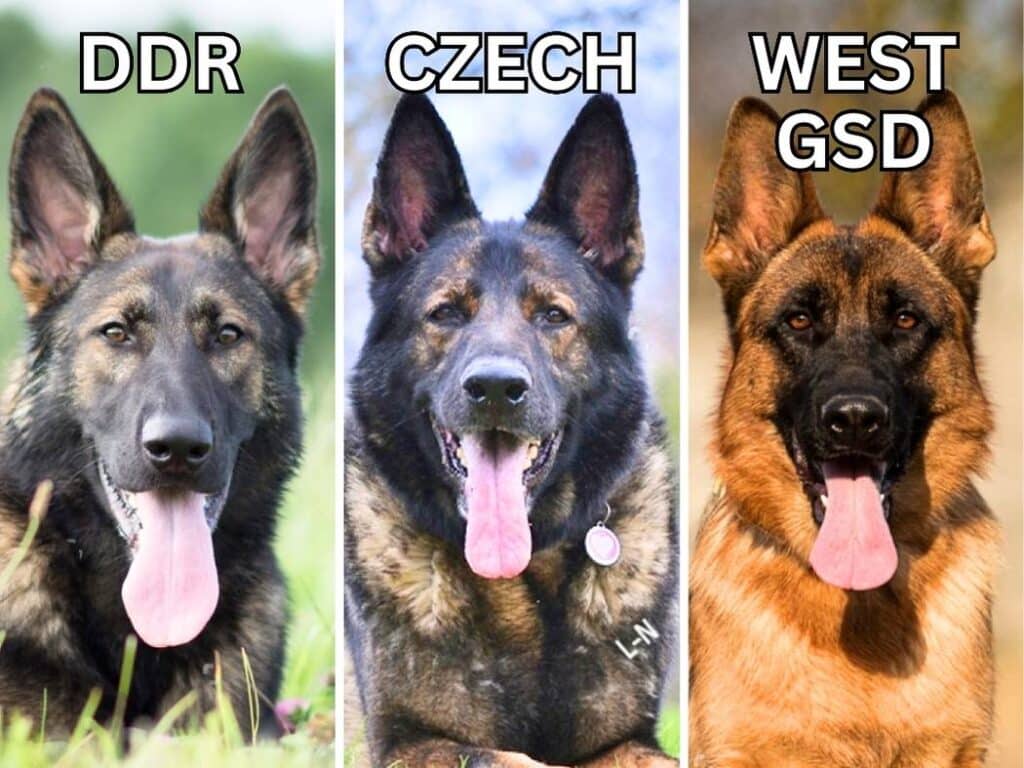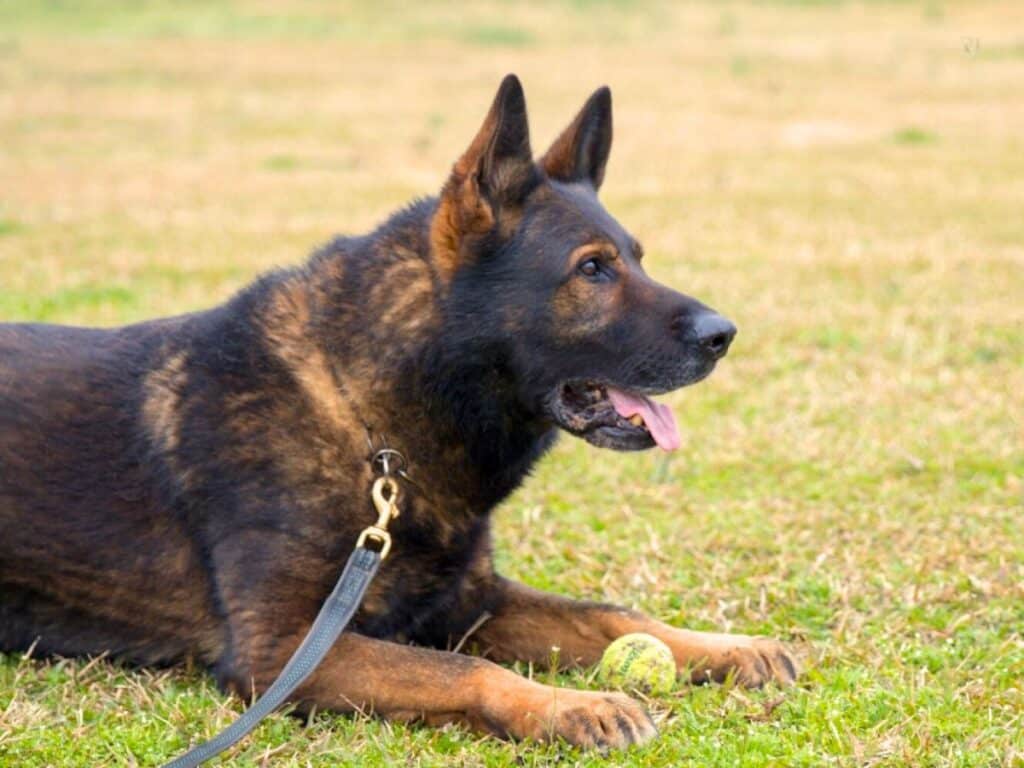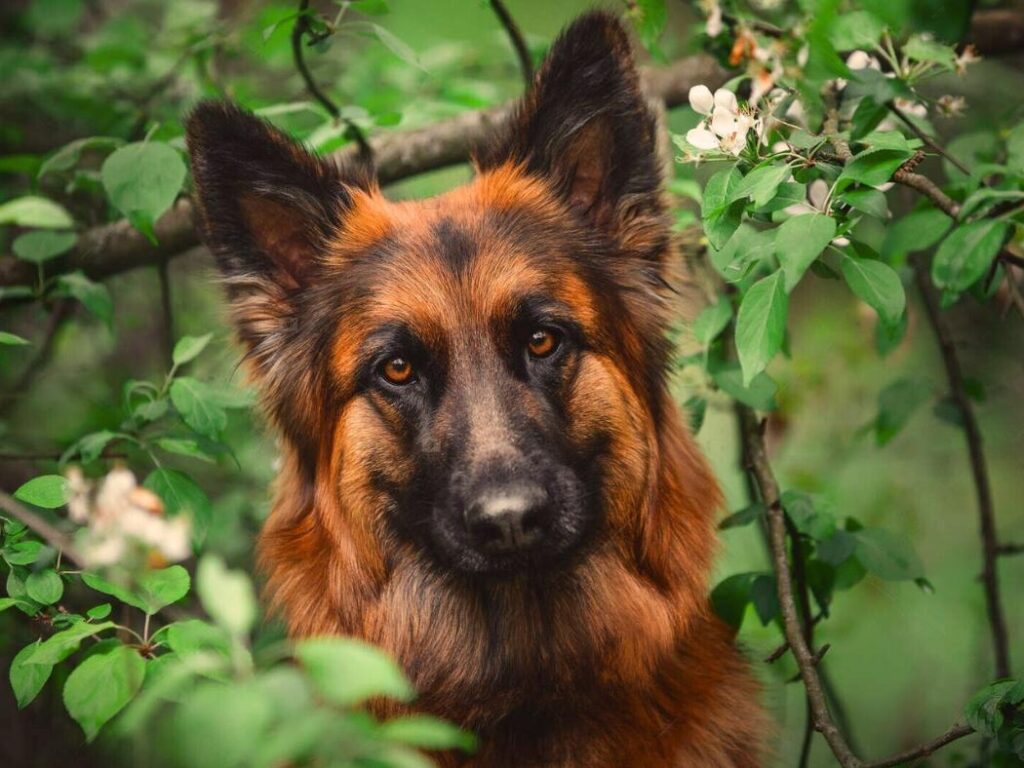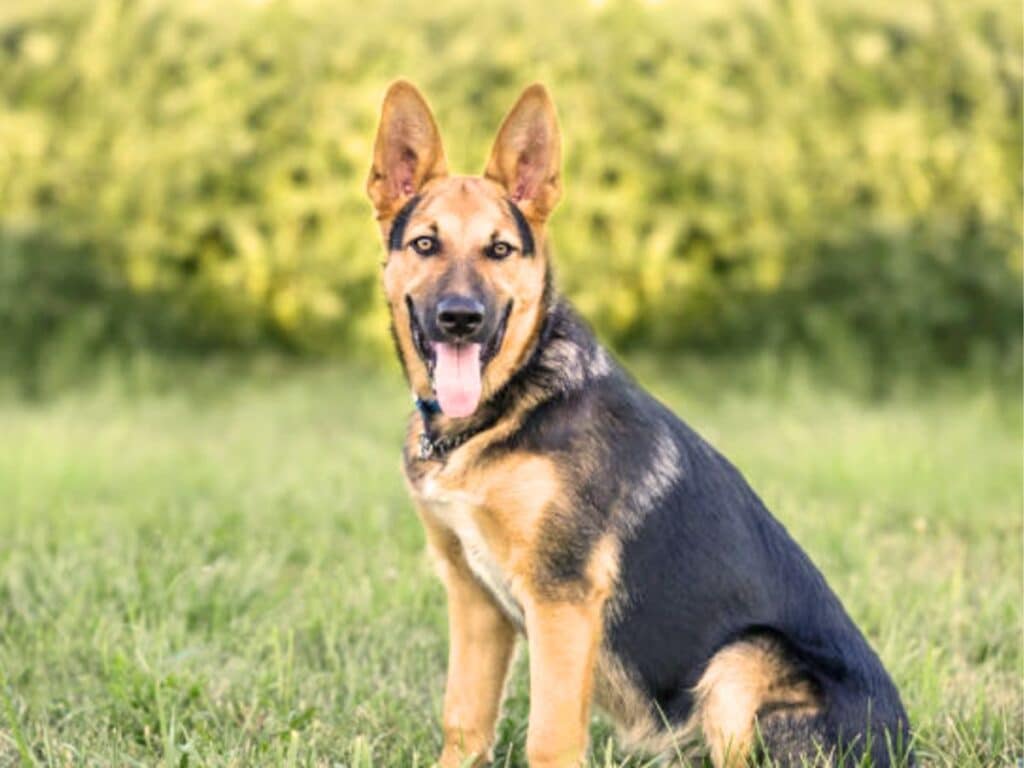Wondering about the differences between DDR/East GSD, Czech GSD, and West German Shepherds? From temperament to physical traits, each type brings its own flair to the table.
In this article, we will compare and contrast:
- DDR East German Shepherds
- West German Shepherds
- Czech German Shepherds
We will discuss their distinctive physical traits and temperaments, and why they were originally bred. We will also discuss the differences in their unique qualities and the roles they play in various contexts.
Let’s get started!
DDR vs West vs Czech German Shepherd
The table below provides a comprehensive comparison between DDR (East German), West German, and Czech German Shepherds.
This table delves into their physical characteristics, temperaments, intelligence, exercise needs, and family compatibility, aiding prospective owners in understanding and choosing the German Shepherd line that aligns best with their preferences and lifestyles.
| Criteria | DDR (East German) German Shepherds | West German Shepherds | Czech German Shepherds |
|---|---|---|---|
| Height | Male: 24″- 26″ Female: 22″-24” | Male: 24″- 26″ Female: 22″- 24” | Male: 24″- 26″ Female: 22″- 24” |
| Weight (lbs.) | Male: 66 – 95 Female: 50 – 80 | Male: 70 – 100 Female: 60 – 80 | Male: 66 – 68 Female: 49 – 61 |
| Origin | Developed in East Germany during the Cold War era. | Developed in West Germany after the country’s division. | Bred in Czechoslovakia. |
| Breeding Purpose | Strict military breeding program, used for guarding, attacking, and police work. | Focus on behavior, personality, temperament, and work drive. | Initially bred for law enforcement, later transitioned to family dogs. |
| Physical Characteristics | Large blocky head, thicker paws, and thick barrel chest. Darker coat color (black or sable). Bite force up to 230 pounds. | Slight slope in the back, regal head, and shoulders. Mostly black coat with tan legs, variable coloring. | Big front paws, a deep chest. Denser bone structure. Sable, black, or a mix of the two colors. |
| Temperament | High energy, high intensity, high working drive. Aggressive, territorial, and resilient. | Loyal, loving, devoted, protective. Balanced temperament, adaptable to family life. | Affectionate with family, mild aggression, trainable to be offensive or passive. |
| Intelligence & Trainability | Developed for endurance, strong will, courage, and high intelligence. Suitable for Schutzhund, police work, and more. | Smart, eager to please, quick learners. Require regular training and socialization. | Considered the smartest among German Shepherd bloodlines. Quick learners, need mental stimulation. |
| Exercise Needs | High activity levels. Thrive on physical and mental stimulation. | 1-2 hours of daily exercise and mental stimulation. High working drive. | 1-2 hours of daily exercise. Not suitable for sedentary families. |
| Family Compatibility | Can be a good family companion with consistent training, and socialization from an early age. | Balanced temperament, adaptable to family life. Versatile and effective in protective roles. | Suitable for families looking for an intimidating yet loyal and affectionate guard dog. Can be patient with kids. |
| Lifespan | 9 – 13 years | 9 – 13 years | 10 – 14 years |
| Price | $800-$6000 | $800-$3000 | $800-$5000 |

DDR/East German Shepherds
What’s a DDR German Shepherd?
The East German Shepherd, or the DDR German Shepherd is a line of GSD breed that was developed in East Germany during the Cold War era.
The ‘DDR German Shepherd’ name originates from Germany’s official name during the period, Deutsche Demokratische Republik, translating to the German Democratic Republic.
Origin of DDR German Shepherds
After World War II, from 1949 until 1990, Germany was divided into the Deutsche Demokratische Republik (DDR) in the East, and the Federal Republic of Germany in the West.
The Soviet Union occupied Eastern Germany, leading to the establishment of the German Democratic Republic (DDR).
This separation is what caused the split in German Shepherd bloodlines that persists to this day.
The East German Communist Party set up a strict breeding program for German shepherd dogs utilized in the military during the Cold War era.
DDR German shepherds emerged from these breeding programs, gaining popularity for their high work drive and working ability.
Strict Breeding Criteria For Military Service
East German Shepherd breeding involved stringent criteria set by the military. Dogs with perceived flaws or health issues, such as hip dysplasia, were excluded from the breeding program.
Breed wardens meticulously assessed each litter for temperament, coat quality, ear set, bone structure, teeth, and overall appearance.
The breeding program focused on producing dogs with strength, large heads, athleticism, and power.
DDR Shepherds played a crucial role in the East German military, particularly in Border Police patrols guarding the East German border and the Berlin Wall. They served as attack, tracking, and guard dogs, also participating in a special unit tracking down deserters.
Post-Berlin Wall Era
The fall of the Berlin Wall in 1989 marked the end of the need for these sentry dogs. Many DDR German Shepherds were abandoned, sold, or euthanized. Some breeders, however, preserved the line by giving or selling these dogs to friends and family.

DDR German Shepherd Temperament
The East German working line was developed with traits that were tailored for harsh conditions, including the ability to withstand winter weather and jump high enough to be able to scale walls.
The regulated breeding programs maintained discipline and standards, resulting in characteristics like high energy levels, high intensity, and a very high working drive.
These dogs were bred only for guarding, attacking, and police work. They thrive on a lot of activity and were designed to be more aggressive, territorial, and resilient compared to other German Shepherd lines.
DDR German Shepherds exhibit qualities akin to human soldiers, including endurance, an iron will, courage, high intelligence, and a strong capacity to maintain focus.
These dogs have a strong temperament, and great working ability and are well suited for Schutzhund, police work, search and rescue, and many other tasks.
Most importantly, DDR German Shepherds have a very low incidence and severity of hip dysplasia.
DDR German Shepherd Physical Characteristics
The DDR Shepherds possess distinctive features such as a large blocky head, thicker paws, and a thick barrel chest.
Their thick bone structure, characterized by low-fat composition and increased muscle mass, contributes to superior athleticism, strength, agility, speed, and stamina.
One noticeable feature of DDR German Shepherds is the darker coat color, often black or sable, with minimal tan coloring on legs, feet, and sometimes on the face and around the ears.
Also, DDR German Shepherds record a bite force of up to 230 pounds, nearly twice that of humans, demonstrating their impressive capabilities in various tasks.
The DDR German Shepherds have a life span of 9-13 years similar to the other lines of the German Shepherd breed.

Popularity and Modern Characteristics
In recent decades, DDR Shepherds have experienced a resurgence in popularity, valued for their capacity to learn, work, and provide companionship.
Originally bred for police and military work, modern DDRs may vary in temperament, ranging from highly driven to more laid back. They are known for their loyalty to the family and wariness towards potential threats.
These dogs are a result of four decades of exclusive breeding and are recognized for their aggression, territorial nature, and resilience. Owners should be aware of their need for high activity levels, as these dogs thrive on constant engagement and stimulation.
Do DDR German Shepherds Make Good Family Dogs?
Deciding whether to get a DDR German Shepherd for your family depends on various factors, including your lifestyle, preferences, and the specific traits of the dog.
Here are some factors to consider if you’re planning to get a DDR/East German Shepherd for your family:
- DDR German Shepherds require consistent training and socialization from an early age so they can grow up to be well-behaved and adaptable family companions.
- These dogs tend to have high energy levels and intensity, so they may require an owner who can provide sufficient physical and mental stimulation to prevent boredom.
- If you enjoy outdoor activities or need an athletic, strong dog with great stamina, a DDR German Shepherd could be a good fit.
- DDR German Shepherds are known for their unwavering loyalty and protective instincts toward their family.
- They are highly adaptable, which is highlighted by their ability to be gentle with family members while still being vigilant against potential threats.
In summary, a DDR German Shepherd can make a wonderful family companion if you are prepared for the commitment involved in their training, exercise, and socialization needs.
RELATED: How Much is a Working Line German Shepherd?

West German Shepherds
Just as the DDR German Shepherds originated in East Germany, the West German Shepherd dogs originated in West Germany after Germany’s division into East and West.
The West German Wroking line is considered the closest representation of the dogs initially bred by Max von Stephanitz, the founder of the German Shepherd breed.
When breeding these working dogs, breeders focus primarily on their behavior, personality, temperament, and work drive. This focus on character over appearance leads to a stronger, more robust, and more energetic working line of dogs.

Physical Appearance of West German Shepherds
These dogs exhibit a slight slope in their backs, falling between the more pronounced slope of the West German show line and the minimal slope of other working line types.
They are typically heavier built and a bit taller at the shoulder compared to DDR GSDs.
Their build, characterized by the regal head and shoulders, is less bulky in the front, allowing for a balanced body designed for speed, agility, and bite force.
Color Variations
Typically, the average West German Shepherd displays a mostly black coat with tan legs, some tan on the face, and occasional white tufts on the back legs and tail.
The coloring in these dogs varies widely compared to show lines, ranging from completely black with minimal tan to predominantly brown.
The black tends to be darker and less uniform, while the tan is usually lighter, and sable is a fairly common occurrence in the West German working line.
West German Shepherd Temperament
West German Shepherds are loyal, loving, devoted, and protective.
While many people opt for the West German Shepherd working line for their work ethic, these dogs can also be wonderful additions to a family if the family puts in the time and effort to train and socialize them properly.
These dogs have a high working drive which requires at least 1-2 hours of daily exercise and mental stimulation. With abundant energy, West GSDs need continuous engagement in high-intensity activities to prevent restlessness.
West German Shepherds are very smart and are eager to please their owners/trainers. This is why they tend to pick up on training and new commands very quickly.

Do West German Shepherds Make Good Family Dogs?
Here are a few factors to consider if you’re planning to get a West German Shepherd working line dog for your family:
- West GSDs have a high working drive, requiring at least 1-2 hours of daily exercise and mental stimulation. If you are not prepared for the commitment of providing regular physical activities, the dog may become restless.
- Like all other GSDs, West working line GSDs too need regular training and socialization from an early age to mature into well-adjusted and family-loving adult dogs.
- West German Shepherds are considered to have a balanced temperament, making them adaptable to family life.
- West German Shepherds are versatile dogs which allows them to be effective both in protective roles and as active family pets.
A working-line West German Shepherd can be a great addition to a family, especially if you are committed to meeting their exercise and mental stimulation needs.
Their balanced temperament, versatility, and striking appearance make them appealing to families seeking an active and loyal canine companion.
RELATED: Working Line vs Show Line German Shepherd

Czech German Shepherds
Czech German Shepherds are working-line German Shepherds first bred in Czechoslovakia in 1955.
After the end of World War 2, East Germany (DDR) and Czechoslovakia, were both under the Soviet Union. So they developed working bloodlines GSDs for use as aids to border guards as well as for use as protection dogs.
Due to the close relationship between the two, Czech German Shepherds and DDR/East German Shepherds are essentially the same bloodline and they share the same traits of masculinity, intellect, vigor, and black coloring.
While initially Czech GSDs had been bred purposefully for law enforcement jobs, they were bred more as family dogs, rather than working dogs, from the time after the reunification of Germany.
Czech GSD Physical Appearance
Czech German Shepherds come in sable, black, or a mix of the two colors. The black look is less prominent than sable. You have to keep in mind that the Czech GSDs were bred for work and not looks.
They also have big front paws, deep chest, and a very powerful jaw. They can be quite furry and can shed a medium amount.
These dogs have a denser bone structure, and they tend to pack on muscle over all that dense bone as they get older, so they look even more athletic & muscular than regular German Shepherds.

Czech GSD Temperament
These dogs were bred for high stamina, strong work ethic, and the ability to follow orders. The latter of these has to do with working intelligence, which is quite high among this line of GSDs.
Their aggression and friendliness are both mild, and they can be trained to be offensive or passive, making them acceptable family dogs.
These dogs are affectionate with their owners family and friends, but can be aloof or a little standoffish with newcomers and strangers.
Relative to most other German Shepherd bloodlines, Czech German Shepherds mature more slowly.
High Intelligence & Easy Trainability
German Shepherds in general are considered to be one of the smartest dog breeds, and many people consider the Czech bloodline to be the smartest among all other German Shepherd bloodlines.
Czech German Shepherds are at their best when they have a job to do or are mastering new skills. They catch on to new commands quite quickly and perfect them faster than average.
Czech German Shepherds need at least 1-2 hours of daily exercise. This dog isn’t suitable for sedentary families, as they will pretty much demand that you get up and play with them multiple times per day.

Do Czech German Shepherds Make Good Family Pets?
Czech GSDs are the dog of choice for those looking for a dog that looks intimidating but can assimilate into a family.
Their protectiveness and ability to be loyal to more than one individual allows them to guard the whole family. They can make terrifying guard dogs, and their very presence in your home may be enough to convince wrongdoers to look elsewhere.
They’re extremely loyal and affectionate, and they can be incredibly patient with kids. Moreover, their high energy level can result in lots of active playtime for the kids.
Check out this Czech Breed Survey System by Von Ultimate Kennels.
Summary
You’ve now got the lowdown on the differences between DDR, Czech, and Western German Shepherds. Each line has its own quirks and qualities that make them unique. Remember, choosing a German Shepherd isn’t just about looks; it’s about finding a furry friend that fits your lifestyle and needs. So, whether you’re drawn to the loyal DDR line, the versatile Czechs, or the adaptable Western Shepherds, make sure to consider what will work best for you and your four-legged companion.




